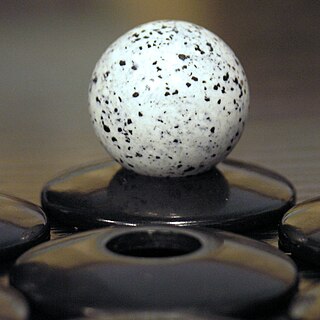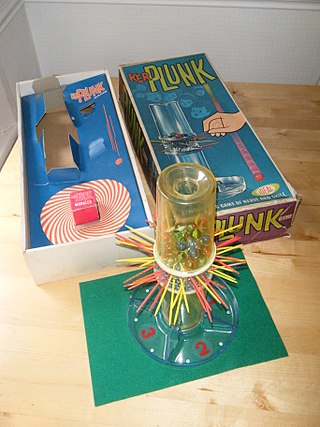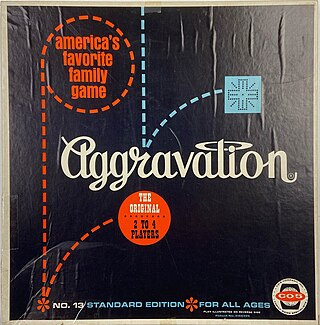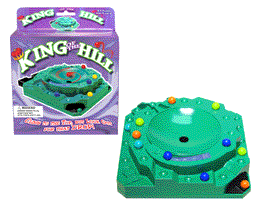
Sternhalma, commonly known as Chinese checkers or Chinese chequers, is a strategy board game of German origin that can be played by two, three, four, or six people, playing individually or with partners. The game is a modern and simplified variation of the game Halma. "Complexity: requires no counting or spelling; even young children can play."

Triominoes is a variant of dominoes using triangular tiles published in 1965. A popular version of this game is marketed as Tri-Ominos by the Pressman Toy Corp.

A microscope slide is a thin flat piece of glass, typically 75 by 26 mm and about 1 mm thick, used to hold objects for examination under a microscope. Typically the object is mounted (secured) on the slide, and then both are inserted together in the microscope for viewing. This arrangement allows several slide-mounted objects to be quickly inserted and removed from the microscope, labeled, transported, and stored in appropriate slide cases or folders etc.

ZÈRTZ is the third game in the GIPF Project of seven abstract strategy games. The game features a shrinking board and an object that promotes sacrifice combinations. It is impartial: since neither player owns on-board pieces, maintaining the initiative is of fundamental importance.

A marble is a small spherical object often made from glass, clay, steel, plastic, or agate. They vary in size, and most commonly are about 13 mm in diameter. These toys can be used for a variety of games called marbles, as well being placed in marble runs or races, or created as a form of art. They are often collected, both for nostalgia and for their aesthetic colors.

Hungry Hungry Hippos is a tabletop game made for 2–4 players, produced by Hasbro, under the brand of its subsidiary, Milton Bradley. The idea for the game was published in 1967 by toy inventor Fred Kroll and it was introduced in 1978. The objective of the game is for each player to collect as many marbles as possible with their "hippo". The game is marketed under the "Elefun and Friends" banner, along with Elefun, Mouse Trap and Gator Golf.

Don't Break the Ice is a children's tabletop game for two to four players ages 3 and up. First marketed by Schaper Toys in 1968, the game was sold to Hasbro subsidiary Milton Bradley in 1986. It is still in production, and special editions were released in conjunction with the films Frozen (2013) and Frozen II (2019).

KerPlunk is a children's game invented by Eddy Goldfarb with Rene Soriano and first marketed by the Ideal Toy Company in 1967. The game consists of a transparent plastic tube, plastic rods called straws and several dozen marbles. The base contains four separate numbered trays; the straws are passed through holes in the middle of the tube to form a lattice. The marbles are then placed in the top of the tube and held in place by the lattice. The onomatopoeic name of the game derives from the sound of the marbles tumbling to the base of the tube during play.
B-Daman is a marble shooting toy franchise produced in Japan by Takara. It was originally based on the Bomberman series, but later expanded into other franchises and its own original designs.
Dr. Nim is a toy invented by John Thomas Godfrey and manufactured by E.S.R., Inc. in the mid-1960s. It consists of a marble-powered plastic computer capable of playing the game of Nim. The machine selects its moves through the action of the marbles falling through the levers of the machine.

Perfection is a game originally produced by the Pennsylvania company Reed Toys and then by the Milton Bradley company. The object is to put all the pieces into matching holes on the board before the time limit runs out. When time runs out, the board springs up, causing many, if not all, of the pieces to fly out. In the most common version, there are 25 pieces to be placed into a 5×5 grid within 60 seconds.

Wahoo is a cross and circle board game similar to Parchisi that involves moving a set number of marbles around the board, trying to get them into the safety zone. The game is alleged to have originated in the Appalachian hills, but it is nearly identical to Mensch Ärgere Dich Nicht, a German board game originating in 1907. Most boards are used by four to six players. Wahoo has been a popular game for decades. Even today, custom-made boards proliferate on eBay and game manufacturer Parker Brothers has sold their own version of the game, under the title Aggravation, for decades.

Aggravation is a board game for up to four players and later versions for up to six players, whose object is to be the first player to have all four playing pieces reach the player's home section of the board. The game's name comes from the action of capturing an opponent's piece by landing on its space, which is known as "aggravating". The name was coined by one of the creators, Lois Elaine, who did not always enjoy defeat.

Pressman Toy Corporation is a toy manufacturer based in Richardson, Texas. Founded in 1922 by Jack Pressman, it currently focuses on family games and licensed products.

King of the Hill is a race game, where players try to be the first to get their marbles from the start to the top of the mountain. It was originally published by Schaper Toys in 1960. It was re-released in 2006 with slightly different rules by Winning Moves Games USA, but is no longer in production.

Stay Alive is a strategy game, where 2-4 players try to keep their marbles from falling through holes in the game board while trying to make their opponents' marbles fall through. It was originally published by Milton Bradley in 1971 and marketed in television and print advertising as "the ultimate survival game". Stay Alive was republished with a smaller board by Winning Moves Games USA in 2005. This game is no longer in production.
Lynn Pressman Raymond was an American business executive who joined her husband Jack Pressman in developing and growing the Pressman Toy Corporation, and was an innovator in creating and licensing toys based on hit television programs and professional athletes in her two decades as president of the firm following her husband's death in 1959.

The British and World Marbles Championship is a marbles knock-out tournament that takes place annually on Good Friday and dates back to 1588. It is held at the Greyhound public house in Tinsley Green, West Sussex. Teams of six players participate to win the title and a silver trophy. The event is open to anyone of any age or nationality. Over the years, players from Australia, Belgium, Canada, Estonia, Ireland, France, Germany, Japan, Netherlands, Wales and the United States have participated alongside English teams.

Avalanche, also marketed as Lawine in the Netherlands, Avalancha in Spain, and Astroslide or Skill in Germany, is an abstract, mechanical strategy game published by Parker Brothers in 1966 that features colored marbles that roll down an inclined board.















